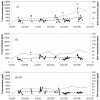Abstract
Although Best Management Practices (BMPs) have been developed to reduce the loss of nutrients, like P, to the environment, limited information exists on the main factors that control P loss to Florida groundwater. For example, while it is generally accepted that both irrigation and fertilizer P impact groundwater P, growers often ask if controlling one is more advantageous than the other in their efforts to reduce P leaching. There exists no easy tool to link fertilizer P input and other factors to groundwater P concentration. This 5-page fact sheet uses long-term data (six growing seasons) from a farm in Immokalee, Florida, to explain the effects of soil and agronomic factors, along with seasonal rainfall, on groundwater P. From these factors are derived simple equations to predict groundwater P concentrations. Written by Sanjay Shukla, Gregory S. Hendricks, Thomas A. Obreza, and Willie Harris, and published by the UF Department of Agricultural and Biological Engineering, August 2014.
References
Hendricks, G.S., S. Shukla, T.A. Obreza, and W.G. Harris. 2014. Measurement and modeling of phosphorous transport in shallow groundwater environments. Journal of Contaminant Hydrology 164: 125-137. Available at http://dx.doi.org/10.1016/j.jconhyd.2014.05.003 https://doi.org/10.1016/j.jconhyd.2014.05.003
Shukla, S., G.S. Hendricks, T.A. Obreza, and W.G. Harris. 2014. BMP-Recommended Water and Phosphorus Inputs for Tomato and Watermelon Can Reduce Environmental Losses of Phosphorus and Save Water. Gainesville: University of Florida Institute of Food and Agricultural Sciences. https://edis.ifas.ufl.edu/ae504. https://doi.org/10.32473/edis-ae504-2014

